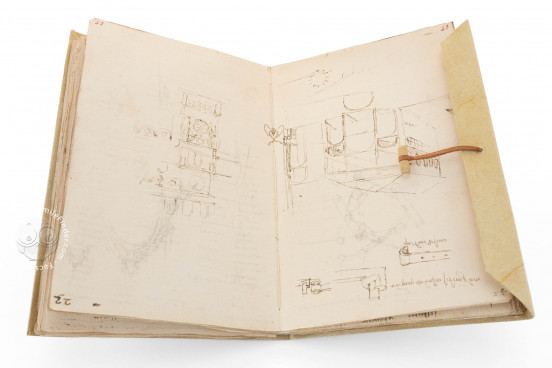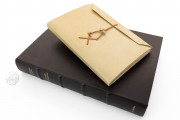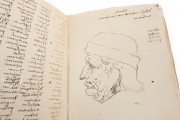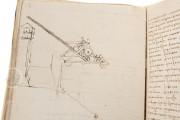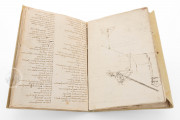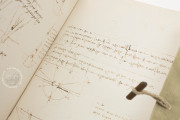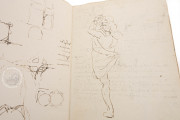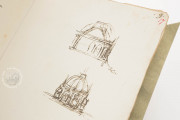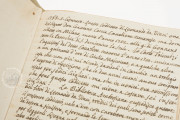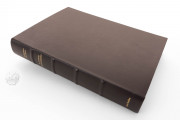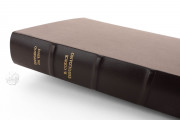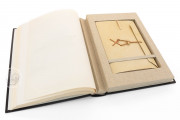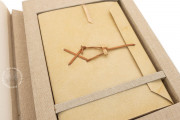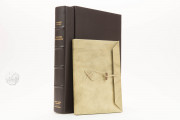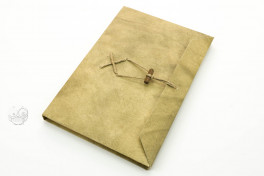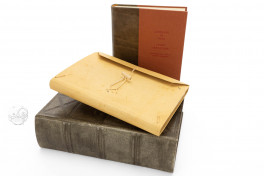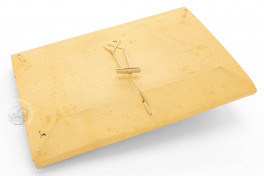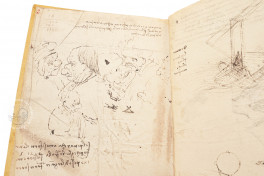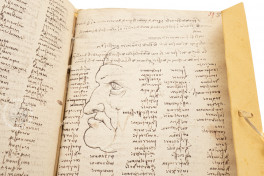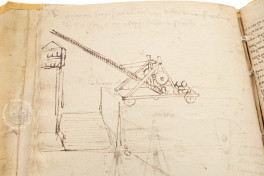Compiled between 1487 and 1490, the Codex Trivulzianus stands as one of the oldest known manuscripts in the corpus of Leonardo's writings. The small paper manuscript is bound in parchment and bears the inscription "Leonardo da Vinci" on its spine. At the manuscript's core are long lists of Latin terms, sometimes followed by explanations of their meanings, which Leonardo likely transcribed from books he was reading at the time.
In addition to the lists of words, the codex also boasts a significant collection of caricature drawings exploring different types of physiognomy that constitute a curious gallery of real and imaginary portraits. Other drawings feature Leonardo's architectural studies for the tiburio of Milan's Cathedral, alongside several military architecture projects.
A Project for a Dictionary?
The Codex Trivulzianus is notable for its extensive lists of words penned in Leonardo's characteristic cursive script from right to left. These lists highlight the artist's efforts to enrich his vocabulary with Latin-origin words, likely aiming to lend more credibility to his scientific writings and to better understand the works of other humanists and scientists. Leonardo often reinterpreted these words, infusing them with new meanings and applying them in various contexts, thus providing us with a valuable linguistic document from that era.
Leonardo also compiled word lists in other codices, particularly in some sheets of the Codex Atlanticus. However, it is in the Codex Trivulzianus that this activity takes on a systematic nature, leading some scholars to speculate that he might have been contemplating the creation of a dictionary for the Italian vernacular.
A Puzzling Pattern
The method Leonardo used to collect these extensive word lists and the order in which he arranged them remains a mystery. Perhaps as he read, he noted new words as they caught his attention, intending to organize them later. He may have also written down many words consecutively, relying on memory rather than books. A few marked lines next to words beginning with A suggest he planned to arrange them alphabetically, but this project remained unfinished.
Occasionally, many words with the same initial letter follow each other in sequence, while at other times, no apparent connection exists between successive words. In this makeshift dictionary, there are a few examples of definitions, preliminary drafts that the writer undoubtedly intended to revise later, yet as they stand, they reinforce the notion that Leonardo aspired to compile an actual dictionary of his local language.
Most of the vocabulary series appear disorganized, and despite efforts to discern the criteria behind the word listings, no definitive pattern emerges. It is puzzling why some words are repeated many times within what was intended to be a framework for a dictionary, with repetitions even occurring on the same page or in succession. Rarely do subsequent words relate, and when they do, it is typically through synonymy.
The Drawings
In the remaining sections not occupied by word lists, Leonardo sketched physiognomic studies, architectural drafts for the Duomo and other Milanese structures, and mechanical designs for war machines. On seven pages, drawings made with a metal stylus are distinctly visible when illuminated from a low angle. Some of these sketches were later traced over with ink.
From Leonardo to the Trivulzio Collection
Following Leonardo's death, the Codex Trivulzianus was bequeathed to his pupil Francesco Melzi. Along with other Leonardo manuscripts, it eventually came into the hands of Pompeo Leoni. In 1632, Galeazzo Arconati acquired the codex and later donated it to the Biblioteca Ambrosiana in 1637, only to retrieve it subsequently in exchange for another Leonardo manuscript. The codex was then lost from record until it resurfaced in the mid-18th century as part of the Trivulzio collection, which was eventually incorporated into the Archivio Storico Civico e Biblioteca Trivulziana within the Castle in 1935.
We have 4 facsimiles of the manuscript "Codex Trivulzianus":
- Codice Trivulziano (Italian Edition) facsimile edition published by Giunti Editore, 1980
- Codice Trivulziano (English Edition) facsimile edition published by Giunti Editore, 1980
- Codice Trivulziano facsimile edition published by Electa, 1980
- Codex Trivulzianus by Leonardo da Vinci facsimile edition published by Collezione Apocrifa Da Vinci, 2018

